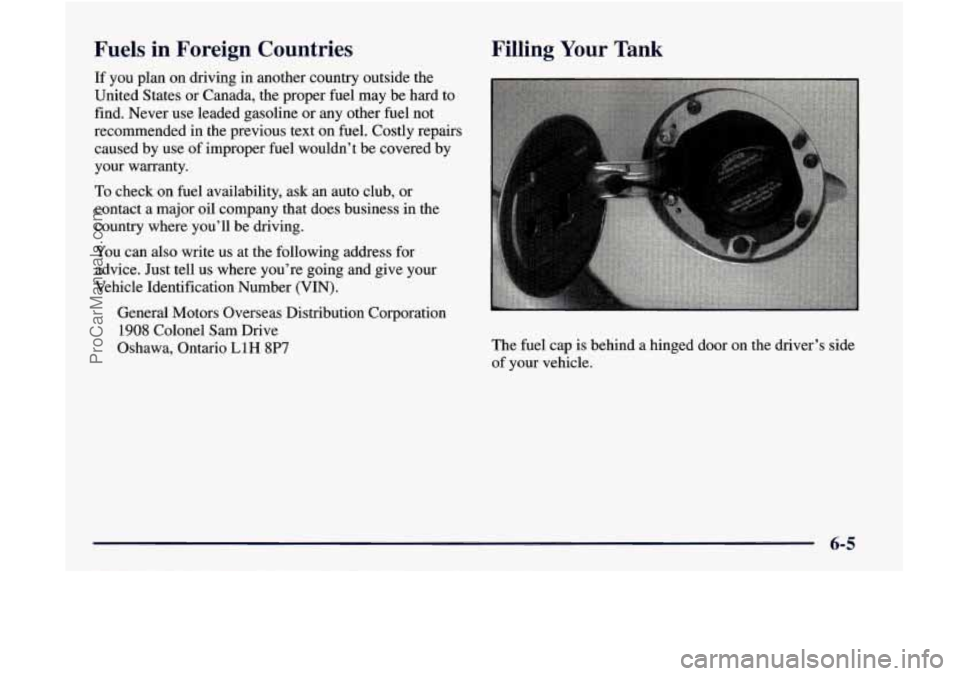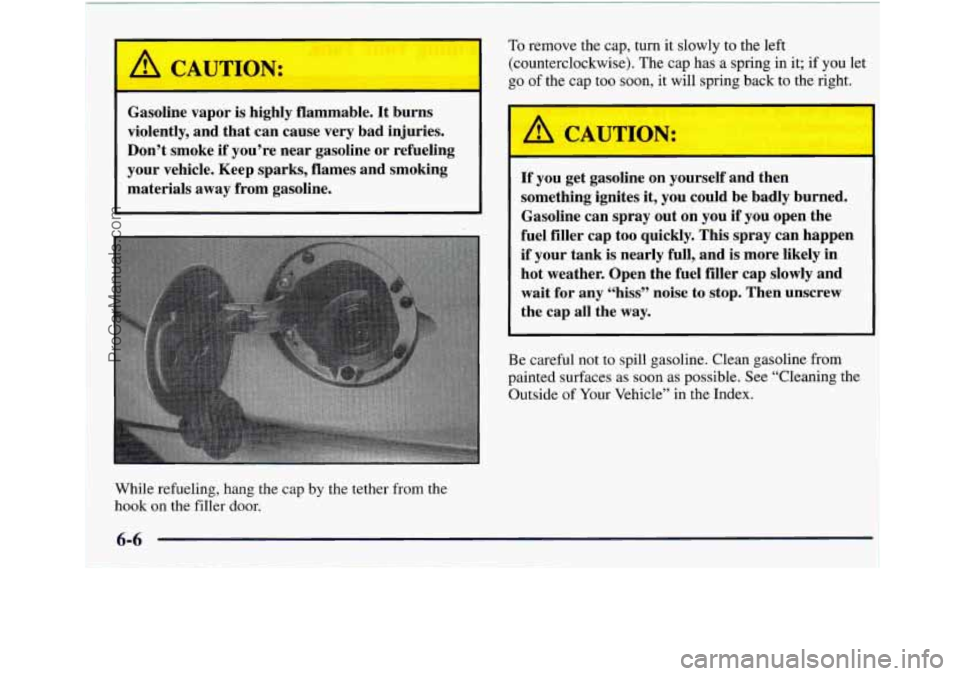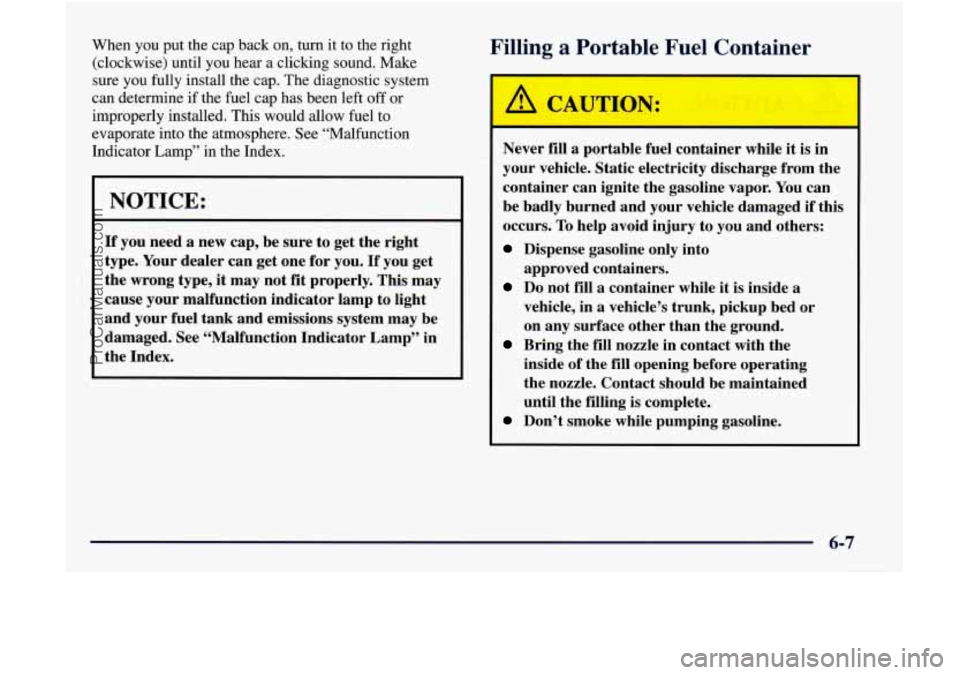GMC ENVOY 1998 Owners Manual
Manufacturer: GMC, Model Year: 1998, Model line: ENVOY, Model: GMC ENVOY 1998Pages: 386, PDF Size: 20.33 MB
Page 251 of 386

If your vehicle is certified to meet California Emission
Standards (indicated on the underhood emission control
label),
it is designed to operate on fuels that meet
California specifications. If such fuels are not available
in states adopting California emissions standards, your
vehicle will operate satisfactorily
on fuels meeting
federal specifications,
but emission control system
performance may be affected. The malfunction indicator
lamp
on your instrument panel may turn on and/or your
vehicle may fail a smog-check test.
If this occurs, return
to your authorized
GM dealer for diagnosis to determine
the cause of failure. In the event it is determined that the
cause of the condition is
the type of fuels used, repairs
may not be covered by your warranty.
Some gasolines that are
not reformulated for low
emissions contain an octane-enhancing additive called
methylcyclopentadienyl manganese tricarbonyl (MMT);
ask your service station operator whether or not his fuel
contains MMT. General Motors does
not recommend the
use of such gasolines. If fuels containing MMT are used,
spark plug life may be reduced and your emission
control system performance may be affected. The
malfunction indicator lamp on your instrument panel
may turn
on. If this occurs, return to your authorized
GM dealer for service.
To provide cleaner air, all gasolines in the United States
are now required to contain additives that will help
prevent deposits from forming
in your engine and fuel
system, allowing your emission control system to
function properly. Therefore, you should not have to add
anything to
the fuel. In addition, gasolines containing
oxygenates, such as ethers and ethanol, and
reformulated gasolines may be available in your area
to
help clean the air. General Motors recommends that you
use these gasolines
if they comply with the
specifications described earlier.
I NOTICE:
Your vehicle was not designed for fuel that
contains methanol. Don’t use it.
It can corrode
metal parts in your fuel system and also damage
plastic and rubber parts. That damage wouldn’t be covered under your warranty.
6-4
ProCarManuals.com
Page 252 of 386

Fuels in Foreign Countries
If you plan on driving in another country outside the
United States or Canada, the proper fuel may be hard to
find. Never use leaded gasoline or any other fuel not
recommended in the previous text on fuel. Costly repairs
caused by use
of improper fuel wouldn’t be covered by
your warranty.
To check on fuel availability, ask an auto club, or
contact a major oil company that does business in the
country where you’ll be driving.
You can also write us at the following address for
advice. Just tell
us where you’re going and give your
Vehicle Identification Number (VIN).
General Motors Overseas Distribution Corporation
1908 Colonel Sam Drive
Oshawa, Ontario
L1H 8P7
Filling Your Tank
The fuel cap is behind a hinged door on the driver’s side
of your vehicle.
6-5
ProCarManuals.com
Page 253 of 386

- , . . .. . , .. , . . . . . . . .
Gasoline vapor is highly flammable. It burns
violently, and that can cause very bad injuries.
Don’t smoke if you’re near gasoline or refueling
your vehicle. Keep sparks, flames and smoking
materials away from gasoline.
While refueling, hang the cap by the tether from the
hook on the filler door.
To remove the cap, turn it slowly to the left
(counterclockwise). The cap has a
spring in it; if you let
go of the cap too
soon, it will spring back to the right.
A CAUTION:
I
If you get gasoline on yourself and then
something ignites it, you could be badly burned.
Gasoline can spray out on you
if you open the
fuel filler cap too quickly. This spray can happen
if your tank
is nearly full, and is more likely in
hot weather. Open the fuel filler cap slowly and
wait for any “hiss” noise
to stop. Then unscrew
the cap all the way.
Be careful not to spill gasoline. Clean gasoline from
painted surfaces as soon as possible. See “Cleaning the
Outside
of Your Vehicle” in the Index.
6-6
ProCarManuals.com
Page 254 of 386

When you put the cap back on, turn it to the right
(clockwise) until you hear a clicking sound. Make
sure you fully install the cap. The diagnostic system
can determine if the fuel cap has been left off or
improperly installed. This would allow fuel to
evaporate into the atmosphere. See “Malfunction Indicator Lamp” in the Index.
NOTICE:
If you need a new cap, be sure to get the right
type. Your dealer can get one for you.
If you get
the wrong type, it may not fit properly. This may
cause your malfunction indicator lamp to light
and your fuel tank and emissions system may be
damaged. See “Malfunction Indicator Lamp” in
the Index.
Filling a Portable Fuel Container
Never fill a portable fuel container while it is in
your vehicle. Static electricity discharge from the
container can ignite the gasoline vapor. You can
be badly burned and your vehicle damaged if this
occurs.
To help avoid injury to you and others:
Dispense gasoline only into
approved containers.
Do not fill a container while it is inside a
vehicle, in a vehicle’s trunk, pickup bed or
on any surface other than the ground.
inside of the
fill opening before operating
the nozzle. Contact should be maintained
until the filling
is complete.
Bring the fill nozzle in contact with the
Don’t smoke while pumping gasoline.
6-7
ProCarManuals.com
Page 255 of 386

Checking Things Under the Hood Then go to the front of the vehicle and release the
secondary hood release.
Things that burn can get on hot engine parts and
start a fire. These include liquids like gasoline,
oil, coolant, brake fluid, windshield washer and
other fluids, and plastic or rubber. You
or others
could be burned. Be careful not to drop
or spill
things that will burn onto
a hot engine.
-
To open the hood, first pull
the handle inside the vehicle
on the lower driver’s side of
the instrument panel. Lift
the hood, release the hood prop from its retainer and
put the hood prop into the slot in the hood.
You may
have
a lamp that comes on when you lift the hood.
6-8
ProCarManuals.com
Page 256 of 386

When you lift the hood, you’ll see these items:
C
A. Battery
B. Coolant Recovery Tank
C. Engine
Oil Dipstick
D. Engine
Oil Fill
E. Transmission Dipstick
E Power Steering Reservoir
G. Brake Master Cylinder
H. Air Cleaner
I. Fuse Block
J. Windshield Washer Fluid
6-9
ProCarManuals.com
Page 257 of 386

Remove the hood prop from the slot in the hood and
return the prop to its retainer.
Then just pull the hood down firmly
to close. It will
latch when dropped from 10 to12 inches (25 to 30 cm)
without pressing on the hood.
Engine Oil
It's a good idea to check your engine oil every time you
get fuel. In order to get an accurate reading, the oil must
be warm and the vehicle must be on level ground.
The oil
yellow dipstick is
a
ring.
Turn off the engine and give the
oil a few minutes to
drain back into the oil pan.
If you don't, the oil dipstick
might
not show the actual level.
6-10
ProCarManuals.com
Page 258 of 386

Checking Engine Oil
Pull out the dipstick and clean it with a paper towel or
cloth, then push it back in all the way. Remove it again,
keeping the tip down, and check the level.
When to Add Engine Oil
If the oil is at or below the ADD line, then you’ll need
to add at least one quart
of oil. But you must use the
right kind. This part explains what kind
of oil to use. For
crankcase capacity, see “Capacities and Specifications”
in the Index.
NOTICE:
Don’t add too much oil. If your engine has so
much oil that the oil level gets above the
cross-hatched area that shows the proper
operating range, your engine could be damaged.
Be sure to fill it enough to put the level somewhere in
the proper operating range. Push the dipstick
all the way
back in when you’re through.
6-11
ProCarManuals.com
Page 259 of 386

What Kind of Eng 3il to Use
Oils recommended for your vehicle can be identified by
looking for the “Starburst” symbol. This symbol
indicates that the oil has been certified by the American
Petroleum Institute (API).
Do not use any oil which
does not carry this Starburst symbol.
If you change your own oil,
be sure you use oil that has
the Starburst symbol on the
front of the
oil container. If
you have your oil changed
for you, be sure the oil
put
into your engine is
American Petroleum
Institute certified
for
gasoline engines.
You should also use the proper viscosity oil for your
vehicle, as shown in the following chart:
I RECOMMENDED SA€ VISCOSITY GRADE ENGINE OILS
FOR BEST FUEL ECONOMY AND COLD STARTING, SELECT THE LOWEST
I SAL VISCOSITY GRADE OIL FOR THE EXPECTED TEMPERATURE RANGE.
L
HOT
WEATHER
+ 20 7
SAE SW-30 PREFERRED
LOOK
FOR MIS
SYMBOL
00 NOT USE SAE 2OW-50 OR ANY OTHER
GRADE OIL NOT RECOMMENDED
6-12
ProCarManuals.com
Page 260 of 386

As shown in the chart, SAE SW-30 is best for your
vehicle. However, you can use
SAE low-30 if it’s going
to be 0°F (- 18°C) or above. These numbers on an oil
container show its viscosity, or thickness. Do
not use
other viscosity oils, such
as SAE 20W-SO.
NOTICE:
Use only engine oil with the American Petroleum
Institute Certified For Gasoline Engines
“Starburst”
symbol. Failure to use the
recommended oil can result in engine damage not
covered by your warranty.
GM Goodwrench@ oil meets all the requirements for
your vehicle.
If you are in an area where the temperature falls below
-20°F (-29”C), consider using either an SAE 5W-30
synthetic oil or an SAE OW-30 oil. Both will provide
easier cold starting and better protection for your engine
at extremely low temperatures.
Engine Oil Additives
Don’t add anything to your oil. Your dealer is ready to
advise if you think something should be added.
When to Change Engine Oil
If any one of these is true for you, use the short tripkity
maintenance schedule:
0 Most trips are less than 5 to 10 miles (8 to 16 km).
This is particularly important when outside
temperatures are below freezing.
driving
in stop-and-go traffic).
off-road frequently. your vehicle.
or other commercial application.
0 Most trips include extensive idling (such as frequent
0 You operate your vehicle in dusty areas or
0 You frequently tow a trailer or use a carrier on top of
0 The vehicle is used for delivery service, police, taxi
Driving under these conditions causes engine oil
to
break down sooner. If any one of these is true for your
vehicle, then you need to change your
oil and filter
every
3,000 miles (5 000 km) or 3 months -- whichever
occurs first.
If none of them is true, use the long trip/highway
maintenance schedule. Change the oil and filter every
7,500 miles (12 500 km) or 12 months -- whichever
occurs first. Driving
a vehicle with a fully warmed
engine under highway conditions causes engine oil
to
break down slower.
6-13
ProCarManuals.com